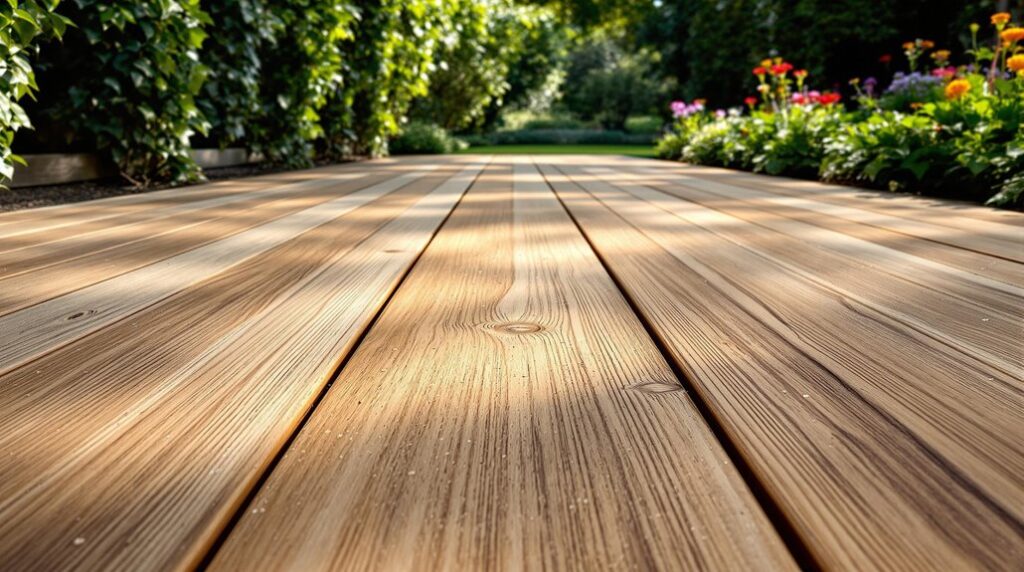I’ve seen countless wooden decks across the UK deteriorate prematurely because homeowners didn’t understand the critical factors that determine lifespan. Your deck’s longevity depends heavily on wood species, climate exposure, and maintenance practices—variables that can mean the difference between replacing boards every decade or enjoying your outdoor space for half a century. The good news? I’ll show you exactly how to identify your deck’s potential lifespan and implement proven strategies that dramatically extend its usable life.
Key Takeaways
- Softwood decking lasts 10-15 years while hardwood species like ipe can last 25-50 years with proper maintenance.
- UK’s frequent rainfall and humidity accelerate timber rot, requiring weekly debris removal and quarterly structural inspections.
- Annual deep cleaning and protective treatments with UV-filtering oils significantly extend wooden decking lifespan and appearance.
- Watch for loose boards, protruding nails, and moisture damage as warning signs requiring immediate repair attention.
- Bi-annual spring and autumn inspections with prompt repairs prevent minor issues from becoming costly major problems.
Wood Species and Their Expected Lifespans in the UK
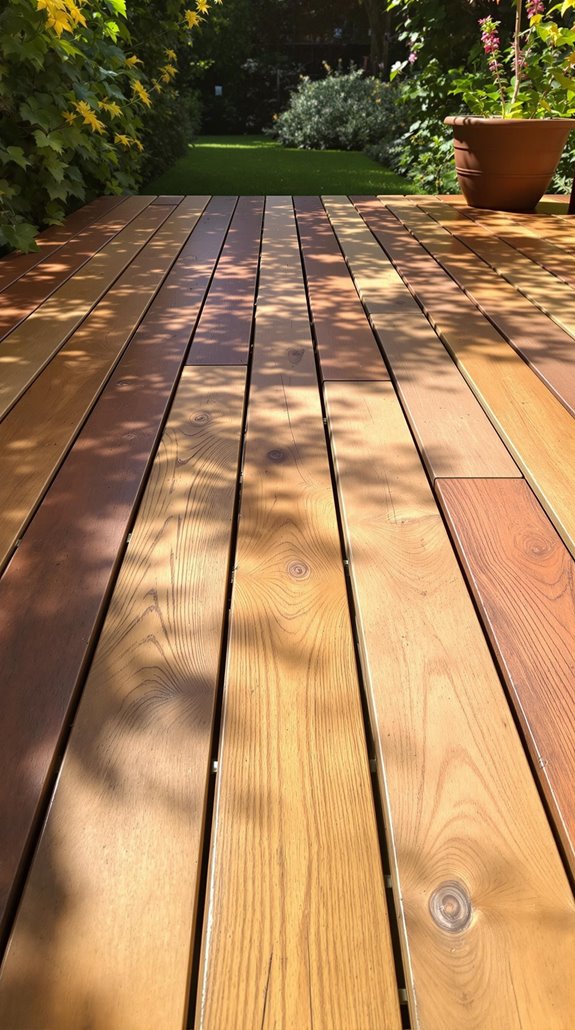
When choosing wooden decking for your UK home, the species you select will fundamentally determine how long your investment lasts. I’ll break down your main options so you can make an informed decision.
Softwood species like pine, cedar, and redwood offer affordability and rustic charm, lasting 10-15 years with consistent maintenance. You’ll need pressure-treating to resist rot and insects, plus bi-annual staining to combat our wet climate.
Hardwood options like ipe, iroko, and yellow balau deliver superior performance, lasting 25-50 years with proper care. They’re naturally resistant to decay and insects without chemical treatment, though you’ll pay more upfront. The environmental impact of hardwood decking includes potential deforestation concerns, particularly with high-demand tropical species.
Pressure-treated softwood bridges the gap, extending lifespan to 15+ years when combined with protective measures like deck tape and composite subframes.
Climate Factors That Affect Wooden Decking Durability
Beyond your wood species choice, the UK’s climate will greatly impact your decking’s longevity. Our frequent rainfall creates prolonged moisture exposure, causing wood to swell, warp, and split. This persistent dampness is the primary culprit behind timber rot, as it promotes fungal growth that breaks down wood fibers. Additionally, real grass helps maintain a balanced ecosystem that can mitigate some of the adverse effects of climate on outdoor surfaces.
Even our moderate sun exposure contributes to deterioration. UV radiation causes wood to crack and fade, particularly in untreated decks. The combination of moisture and sun creates damaging wet-dry cycles that accelerate degradation.
High humidity levels encourage mold, mildew, and insect infestations that feed on moist wood. If you’re in coastal areas, you’ll face additional challenges. Salt air is highly corrosive and draws moisture into timber, creating an aggressive environment that considerably reduces your deck’s lifespan. The UK’s damp, temperate maritime climate can degrade wood decking quickly, making proper wood selection crucial for long-term durability.
Essential Maintenance Tasks for Maximum Longevity
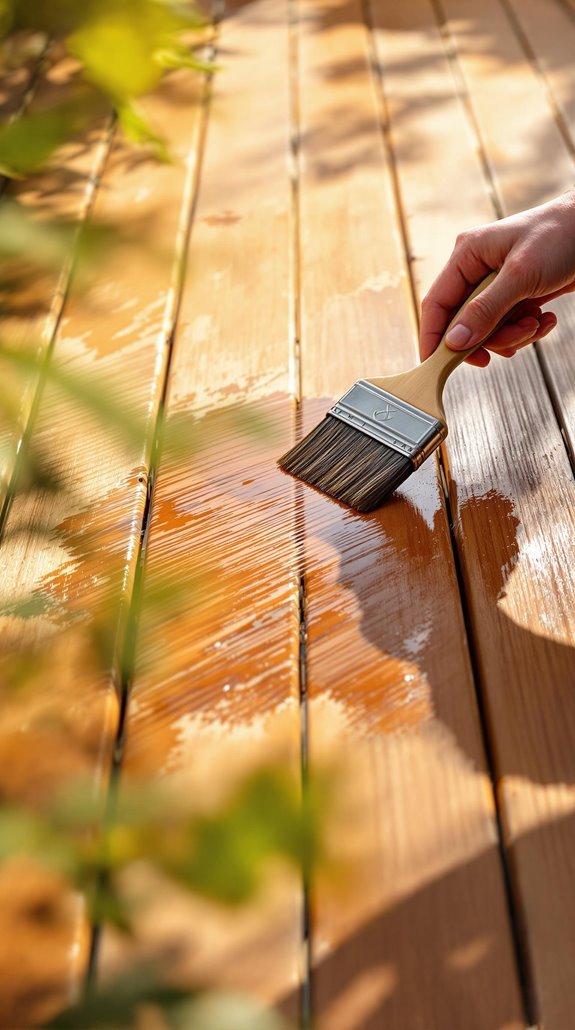
While environmental factors largely determine your deck’s potential lifespan, consistent maintenance practices will determine whether you’ll achieve that maximum durability. I’ll guide you through five essential maintenance categories that serious deck owners follow.
Start with weekly debris removal—sweep surfaces and clear gaps of leaves to prevent moisture retention and rot. Conduct quarterly structural inspections, checking for soft spots and loose fasteners that indicate developing problems. Address damage immediately by replacing rotted boards and filling cracks with exterior-grade wood filler.
Perform annual deep cleaning using power washing along the grain direction, pre-treating mould with eco-friendly cleaners. Apply protective coatings when existing sealant shows wear to maintain the wood’s defense against moisture and UV damage. Finally, implement seasonal preparation by clearing drainage channels and storing furniture during winter months. These systematic practices separate successful deck owners from those facing premature replacement costs.
Protective Treatments to Shield Your Deck From Damage
Although maintenance prevents immediate problems, protective treatments form your deck’s primary defense against long-term environmental damage. I’ll guide you through the essential options that serious deck owners rely on.
All-in-one decking oils deliver the most thorough protection. They oil, stain, and shield simultaneously with built-in UV filters while preventing timber splitting. You’ll need two coats for ideal coverage.
For maximum durability, I recommend pre-treating with wood preservers first. They shield against mould, algae, and rot but require overcoating with oils or stains after several days’ drying. Paint sprayers offer a premium option for applying treatments, using less product than traditional brushes or rollers.
Outdoor decking paints offer robust protection against foot traffic when properly primed. Always clean your deck with biocidal wash before applying any treatment, and test products on inconspicuous areas first.
Regular Inspection and Prompt Repair Strategies

Since protective treatments can’t prevent all damage, systematic inspections become your most reliable tool for catching problems before they escalate into costly repairs. I recommend conducting bi-annual inspections in spring and autumn, plus immediate checks after storms or heavy snowfall. During monthly visual sweeps, you’ll spot surface debris and discoloration early.
When inspecting, probe wood with a screwdriver—soft areas indicate rot requiring immediate attention. Look for dark streaks, warped boards, and peeling finishes that expose untreated wood. Test railings for wobbling and examine ledger board connections for corrosion. Check joist hangers for rust or separation, and replace any rusted fasteners immediately. Proper insulation, particularly in the attic and walls, can also help prevent moisture issues that may affect your decking.
Follow my urgency protocol: replace rotted boards within 48 hours, stabilize loose railings instantly, and address drainage issues before forecasted rain. Remember that proper maintenance can extend your softwood decking’s life to around 15 years, making these inspection efforts worthwhile investments in your deck’s longevity.
When to Call in Professional Deck Specialists
Professional intervention becomes essential when deck problems exceed basic maintenance capabilities or threaten structural integrity. I recommend calling specialists when you notice sagging, bouncing, or visible beam damage – these indicate foundational compromise that’s beyond DIY fixes. You’ll need professional help for loose fasteners causing instability, rotted posts requiring replacement, or railings detaching from substructure.
Complex issues like widespread composite mold infiltration, hardwood exhibiting deep checking, or persistent warping across multiple boards demand specialized expertise. I’d also contact professionals for multi-level construction, integrated lighting features, or custom shapes requiring precise structural adaptation.
Don’t forget regulatory requirements – decks exceeding 600mm height need compliant balustrade systems, while commercial projects require certified load documentation. Manufacturer warranties often mandate professional installation too. When selecting contractors, prioritize those with professional membership in recognized industry associations, as this ensures quality assurance and adherence to construction standards.
Signs Your Wooden Decking Needs Immediate Attention
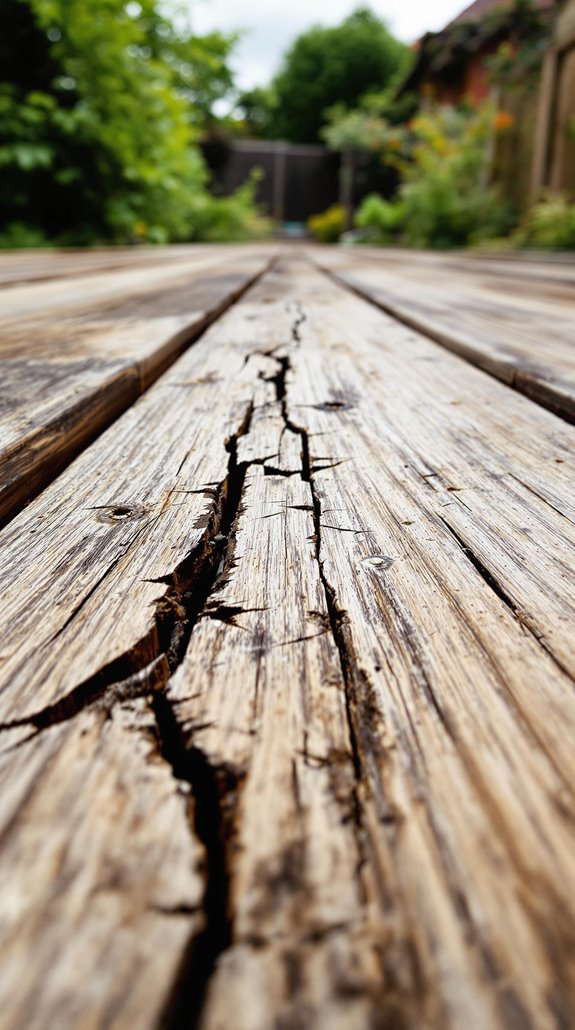
Beyond knowing when to call professionals, you must recognize warning signs that demand immediate action to prevent costly damage or dangerous failures. I’ve identified critical indicators that require urgent attention.
Structural issues include loose boards creating tripping hazards, protruding nails, and railings shifting under pressure. You’ll notice boards levering upward from moisture damage or visible sagging sections indicating foundation problems.
Biological damage appears as clustered holes from wood-boring insects, soft spongy wood texture from advanced rot, and visible fungal growth beneath boards. Don’t ignore termite activity in structural supports.
Surface deterioration includes widespread splintering, deep gouges exposing untreated wood, and cracked sealant exceeding 30% coverage. Moisture damage manifests as standing water pooling over 24 hours and darkened grain indicating internal retention. Address these issues through seasonal maintenance to prevent further deterioration and extend your deck’s lifespan.
Cost-Effective Ways to Extend Your Deck’s Life
Most homeowners can considerably extend their deck’s lifespan through strategic maintenance practices that cost far less than premature replacement. I’ll share the most effective approaches that deliver real results.
Annual cleaning and sealing represents your best investment. Remove debris promptly to prevent moisture retention, then apply quality sealants with UV protection. Don’t skip hidden areas—comprehensive coverage prevents costly surprises later. Regular treatment ensures your timber deck maintains its structural integrity and appearance over time.
Address repairs immediately when you spot them. Replace rotted boards before decay spreads, and use wood hardeners for localized damage instead of full replacement. Tighten loose fasteners to maintain structural integrity.
Create a maintenance schedule you’ll actually follow. Track treatments in a log, budget for preventative measures, and combine tasks like cleaning and sealing. This systematic approach prevents expensive emergency repairs while maximizing your deck’s longevity.
Seasonal Care Tips for Year-Round Protection
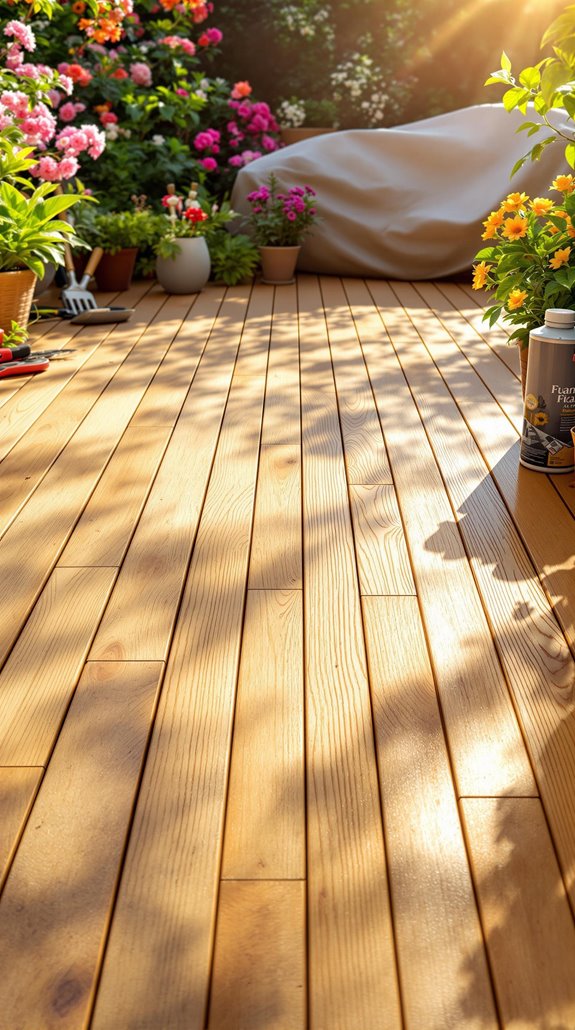
Year-Round Inspection and Maintenance
- Inspect your deck periodically for damage, mold, and mildew
- Check railings and balusters for stability throughout the year
- Secure fasteners as needed to maintain structural integrity
- Sand splintered areas immediately to prevent injuries
- Consider using recycled materials for repairs or enhancements to keep costs low.
Cleaning Throughout the Year
- Remove debris, leaves, and dirt from deck surfaces and between boards regularly
- Use pressure washers or deck cleaners to remove built-up grime periodically
- Clean and treat mold and mildew promptly to prevent spread
- Schedule deep cleaning in spring to address winter accumulation
- Regularly sweep your deck to prevent dirt and debris buildup that can cause long-term damage
Upgrading Options for Aging Wooden Decks
When proper maintenance can no longer restore your wooden deck’s functionality and appearance, it’s time to explore replacement options that better suit your long-term needs.
I’d recommend composite decking as your strongest upgrade choice. While you’ll face higher upfront costs, you’ll eliminate annual staining, sealing, and pest control expenses. The material combines 60% recycled wood fibers with 40% recycled plastic, delivering superior rot and UV resistance that outlasts traditional wood. Additionally, opting for a composite material can help you avoid potential legal issues related to permitted development rights.
For budget-conscious homeowners, thermowood offers excellent value at £25-30/m² plus VAT. Its heat-treated pine construction resists warping without chemical treatments, making precise cuts possible for complex designs.
If you’re seeking ultra-low maintenance, consider making a shift to gravel surfacing. At under £10/m², it requires only occasional raking and provides excellent drainage for your outdoor space. You’ll also need to install a membrane underneath to prevent weed growth from compromising your new surface.
Conclusion
I’ve covered the key factors that determine your wooden decking’s lifespan in the UK. You’ll get 10-15 years from softwoods and up to 50 years from hardwoods with proper care. Don’t skip weekly debris removal, quarterly inspections, and annual deep cleaning. Apply protective treatments regularly and address repairs promptly. Follow these maintenance practices consistently, and you’ll maximize your deck’s longevity while avoiding costly replacements. Your deck’s lifespan depends entirely on how well you maintain it.
References
- https://hampshireturfsupplies.co.uk/how-long-does-decking-last/
- https://www.oaklandfls.co.uk/how-long-does-decking-last/
- https://blazeboard.co.uk/analyzing-the-lifespan-of-timber-decking-and-the-benefits-of-non
- https://mrsander.co.uk/deck-maintenance/understanding-the-lifespan-of-your-deck/
- https://www.qtdgroup.com/post/evaluating-deck-wood-durability-key-factors-and-lifespan-expectations
- https://www.ghclark.com/deck-life-and-maintenance-how-long-does-a-wooden-deck-last/
- https://ecochoice.co.uk/how-long-should-my-decking-last/
- https://finetunefencingfarnborough.co.uk/blog/what-is-the-correct-wood-for-decking-in-the-uk/
- https://georgiaoutdoorliving.com/blog/how-long-does-a-wood-deck-last-essential-insights-maintenance-tips/
- https://www.acornfencingaldershot.co.uk/blog/what-is-the-strongest-wood-for-decking-uk/

